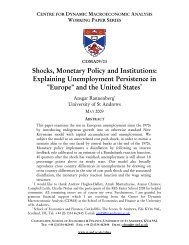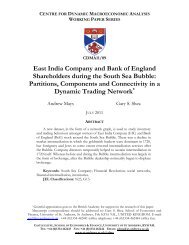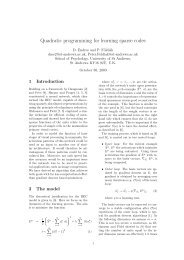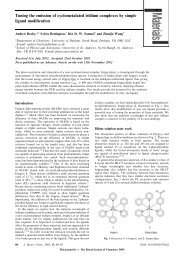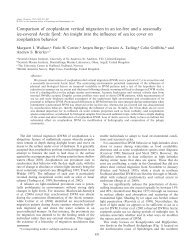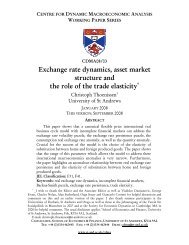Delay and Haircuts in Sovereign Debt - University of St Andrews
Delay and Haircuts in Sovereign Debt - University of St Andrews
Delay and Haircuts in Sovereign Debt - University of St Andrews
Create successful ePaper yourself
Turn your PDF publications into a flip-book with our unique Google optimized e-Paper software.
(<br />
s)<br />
2<br />
is the creditor’s cont<strong>in</strong>uation value. By computation, it follows that<br />
~x 2 = 2 <br />
2 +<br />
s<br />
2 . Let x0 2 be any positive number such that x0 ( s)<br />
2 <<br />
2<br />
,<br />
<br />
+<br />
s<br />
2 .<br />
where ~x 2 < x 0 2 < . It follows that x0 2 > 2 <br />
2<br />
In a mixed strategy 21 , the Optimistic debtor may r<strong>and</strong>omize between a<br />
high o¤er ~x 2 <strong>and</strong> a low o¤er x 0 2 . Suppose the Optimistic debtor o¤ers<br />
(~x 2 ; ~x 2 ) with a probability (1 ) <strong>and</strong> o¤ers (x 0 2 ; x0 2 ) with a probability<br />
, while the Cautious debtor o¤ers (x 0 2 ; x0 2 ) with a probability 1.<br />
Recall that the creditor’s posterior belief at t = 3, is given by q 1 = s<br />
.<br />
Updat<strong>in</strong>g the belief accord<strong>in</strong>g to the Bayesian updat<strong>in</strong>g rule implies that, <strong>in</strong><br />
the equilibrium, the Optimistic debtor o¤ers (x 0 2 ; <br />
such that q 1 =<br />
that<br />
q 0<br />
q 0 +(1<br />
Solv<strong>in</strong>g equation (A4) for yields:<br />
x0 2 ) with a probability<br />
q 0 ) , where q 0 is the creditor’s prior belief. It follows<br />
q 0<br />
q 0 + (1 q 0 ) = s<br />
: (A4)<br />
s 1<br />
=<br />
s<br />
To ensure that < 1, it requires that<br />
s 1<br />
s<br />
q 0<br />
q0<br />
<br />
q 0<br />
q0<br />
<br />
.<br />
< 1 , (1 q 0 ) < s , q 0 > s<br />
: (A5)<br />
Condition (A5) implies that, for a delay <strong>in</strong> the second period to exist,<br />
the susta<strong>in</strong>ability concern needs to be su¢ ciently important or the creditor’s<br />
prior that the debtor is Optimistic is su¢ ciently high s<strong>in</strong>ce, <strong>in</strong> these two<br />
cases, the value <strong>of</strong> signall<strong>in</strong>g is greater. As long as q 0 > s , there exists<br />
<br />
2 (0; 1) which solves equation (A4). For the creditor, by observ<strong>in</strong>g x 0 2 , it<br />
follows that q 1 = s<br />
. Given q 1 = s<br />
<br />
, the creditor is <strong>in</strong>di¤erent between<br />
accept<strong>in</strong>g (~x 2 ; ~x 2 ) <strong>and</strong> reject<strong>in</strong>g it (<strong>and</strong> obta<strong>in</strong>s his cont<strong>in</strong>uation value).<br />
From condition (A5), we have q 0 > s<br />
<br />
. Let us denote the lower bound<br />
for q 0 by q = s<br />
. It is obvious that q0 1 < q. The creditor accepts (~x 2; ~x 2 )<br />
with a probability <strong>and</strong> rejects it with a probability (1 ). After observ<strong>in</strong>g<br />
the o¤er (x 0 2 ; x0 2 ), the creditor rejects the debtor’s o¤er with a probability<br />
1. The debtor’s expected payo¤ from an o¤er (~x 2 ; ~x 2 ) is given by ~x 2 +<br />
(1 ) <br />
2 , where<br />
<br />
2<br />
is the cont<strong>in</strong>uation value for the Optimistic debtor,<br />
21 See Spence (1974) <strong>and</strong> Fudenberg <strong>and</strong> Tirole (1991).<br />
30



